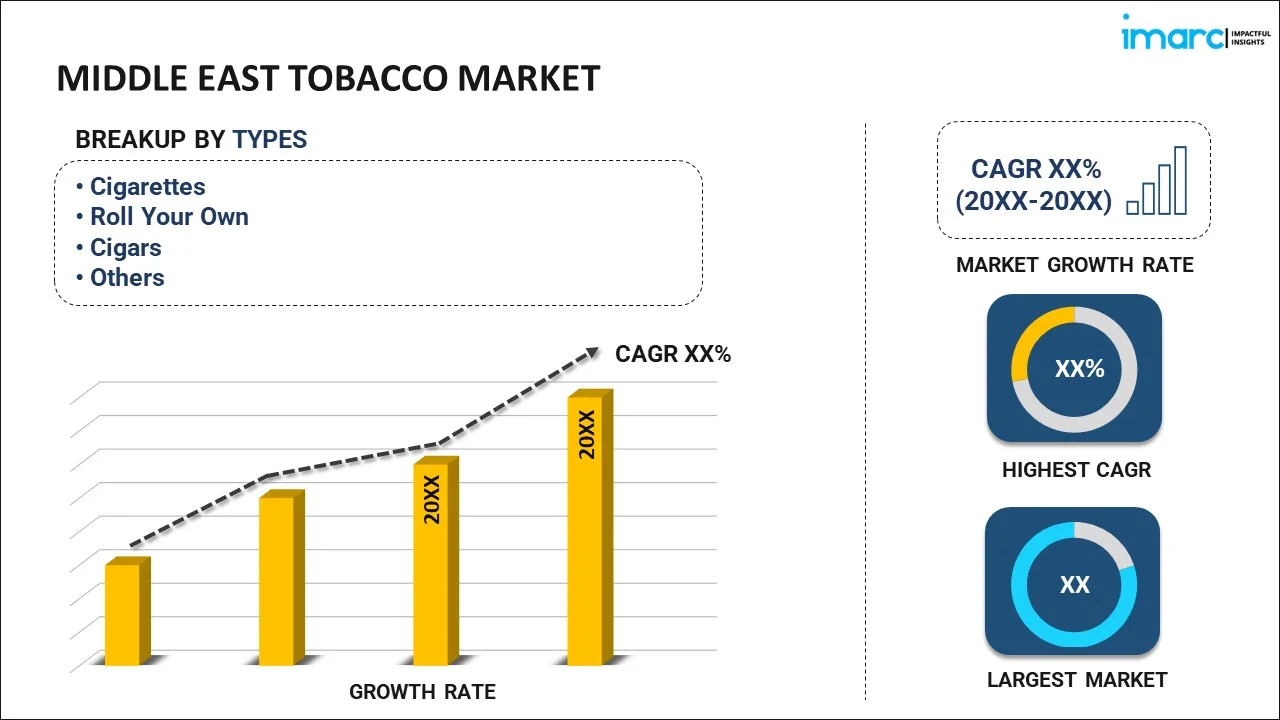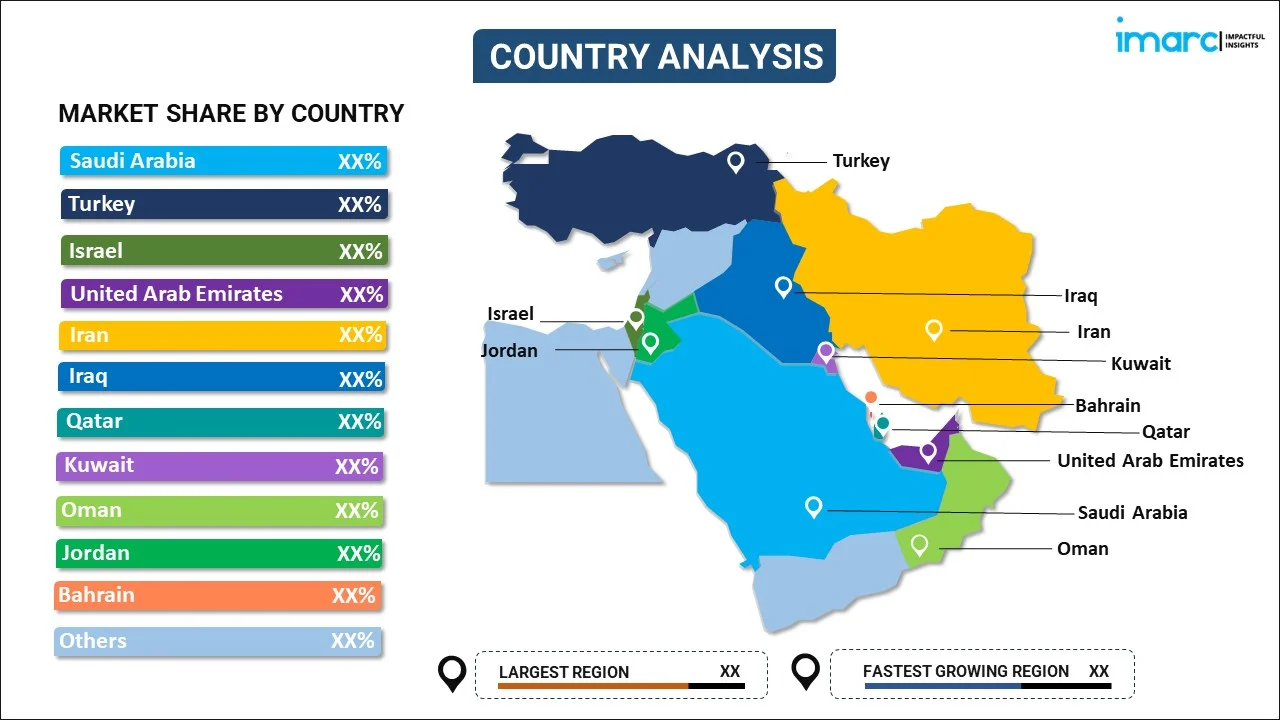
Middle East Tobacco Market Report by Type (Cigarettes, Roll Your Own, Cigars, Cigarillos, Smokeless Tobacco, and Others), and Country 2024-2032
Market Overview:
Middle East tobacco market size is projected to exhibit a growth rate (CAGR) of 2.10% during 2024-2032. The inflating popularity of smoking, as it is often perceived as a symbol of social status or a means of bonding during social gatherings, is primarily driving the market growth.
|
Report Attribute
|
Key Statistics
|
|---|---|
|
Base Year
|
2023 |
|
Forecast Years
|
2024-2032
|
|
Historical Years
|
2018-2023
|
| Market Growth Rate (2024-2032) | 2.10% |
Tobacco, scientifically known as nicotiana tabacum, is a plant predominantly grown for its leaves that harbor nicotine, a highly addictive alkaloid. Originally native to the Americas, where indigenous cultures traditionally employed it for diverse purposes, tobacco is now consumed in various forms such as cigarettes, cigars, pipe tobacco, and smokeless products like snuff and chewing tobacco. The cultivation process involves sowing seeds in meticulously prepared fields, nurturing them into seedlings, and subsequently transplanting them to larger fields for maturation. The leaves undergo careful hand-harvesting and are then subjected to different curing methods, including air-curing, flue-curing, fire-curing, or sun-curing. Beyond its agricultural aspects, tobacco, due to the presence of nicotine, acts as a stimulant, triggering the release of neurotransmitters like dopamine and eliciting a sense of pleasure and relaxation.
Middle East Tobacco Market Trends:
The Middle East's tobacco market occupies a prominent space influenced by cultural traditions, economic factors, and evolving consumer behaviors. While tobacco cultivation has historical roots in the region, the contemporary market reflects a complex interplay of traditional practices and changing preferences. Additionally, the Middle East's tobacco market is characterized by diverse consumption patterns, encompassing various forms like cigarettes, waterpipes (shisha), and smokeless tobacco products. Despite global health trends encouraging reduced tobacco use, the region has seen a sustained demand for traditional smoking methods. Apart from this, waterpipe smoking, in particular, is deeply embedded in the cultural fabric, serving as a social activity in many Middle Eastern societies, which is acting as another significant growth-inducing factor. The market dynamics are also influenced by regulatory measures and taxation policies implemented by governments to address public health concerns. While there is a growing awareness of the health risks associated with tobacco use, the Middle East tobacco market continues to adapt, with a notable presence of international and local tobacco companies. The prevalence of tobacco-related cultural practices and the coexistence of modern and traditional attitudes toward smoking is expected to underscore the intricate nature of the Middle East's tobacco market over the forecasted period.
Middle East Tobacco Market Segmentation:
IMARC Group provides an analysis of the key trends in each segment of the market, along with forecasts at the regional and country levels for 2024-2032. Our report has categorized the market based on type.
Type Insights:

- Cigarettes
- Roll Your Own
- Cigars
- Cigarillos
- Smokeless Tobacco
- Others
The report has provided a detailed breakup and analysis of the market based on the type. This includes cigarettes, roll your own, cigars, cigarillos, smokeless tobacco, and others.
Country Insights:

- Saudi Arabia
- Turkey
- Israel
- United Arab Emirates
- Iran
- Iraq
- Qatar
- Kuwait
- Oman
- Jordan
- Bahrain
- Others
The report has also provided a comprehensive analysis of all the major regional markets, which include Saudi Arabia, Turkey, Israel, United Arab Emirates, Iran, Iraq, Qatar, Kuwait, Oman, Jordan, Bahrain, and Others.
Competitive Landscape:
The market research report has also provided a comprehensive analysis of the competitive landscape. Competitive analysis such as market structure, key player positioning, top winning strategies, competitive dashboard, and company evaluation quadrant has been covered in the report. Also, detailed profiles of all major companies have been provided.
Middle East Tobacco Market Report Coverage:
| Report Features | Details |
|---|---|
| Base Year of the Analysis | 2023 |
| Historical Period | 2018-2023 |
| Forecast Period | 2024-2032 |
| Units | US$ Million |
| Scope of the Report | Exploration of Historical and Forecast Trends, Industry Catalysts and Challenges, Segment-Wise Historical and Predictive Market Assessment:
|
| Types Covered | Cigarettes, Roll Your Own, Cigars, Cigarillos, Smokeless Tobacco, Others |
| Countries Covered | Saudi Arabia, Turkey, Israel, United Arab Emirates, Iran, Iraq, Qatar, Kuwait, Oman, Jordan, Bahrain, Others |
| Customization Scope | 10% Free Customization |
| Report Price and Purchase Option | Single User License: US$ 3699 Five User License: US$ 4699 Corporate License: US$ 5699 |
| Post-Sale Analyst Support | 10-12 Weeks |
| Delivery Format | PDF and Excel through Email (We can also provide the editable version of the report in PPT/Word format on special request) |
Key Questions Answered in This Report:
- How has the Middle East tobacco market performed so far and how will it perform in the coming years?
- What has been the impact of COVID-19 on the Middle East tobacco market?
- What is the breakup of the Middle East tobacco market on the basis of type?
- What are the various stages in the value chain of the Middle East tobacco market?
- What are the key driving factors and challenges in the Middle East tobacco?
- What is the structure of the Middle East tobacco market and who are the key players?
- What is the degree of competition in the Middle East tobacco market?
Key Benefits for Stakeholders:
- IMARC’s industry report offers a comprehensive quantitative analysis of various market segments, historical and current market trends, market forecasts, and dynamics of the Middle East tobacco market from 2018-2032.
- The research report provides the latest information on the market drivers, challenges, and opportunities in the Middle East tobacco market.
- Porter's five forces analysis assist stakeholders in assessing the impact of new entrants, competitive rivalry, supplier power, buyer power, and the threat of substitution. It helps stakeholders to analyze the level of competition within the Middle East tobacco industry and its attractiveness.
- Competitive landscape allows stakeholders to understand their competitive environment and provides an insight into the current positions of key players in the market.
Need more help?
- Speak to our experienced analysts for insights on the current market scenarios.
- Include additional segments and countries to customize the report as per your requirement.
- Gain an unparalleled competitive advantage in your domain by understanding how to utilize the report and positively impacting your operations and revenue.
- For further assistance, please connect with our analysts.
 Inquire Before Buying
Inquire Before Buying
 Speak to an Analyst
Speak to an Analyst
 Request Brochure
Request Brochure
 Request Customization
Request Customization




.webp)




.webp)












